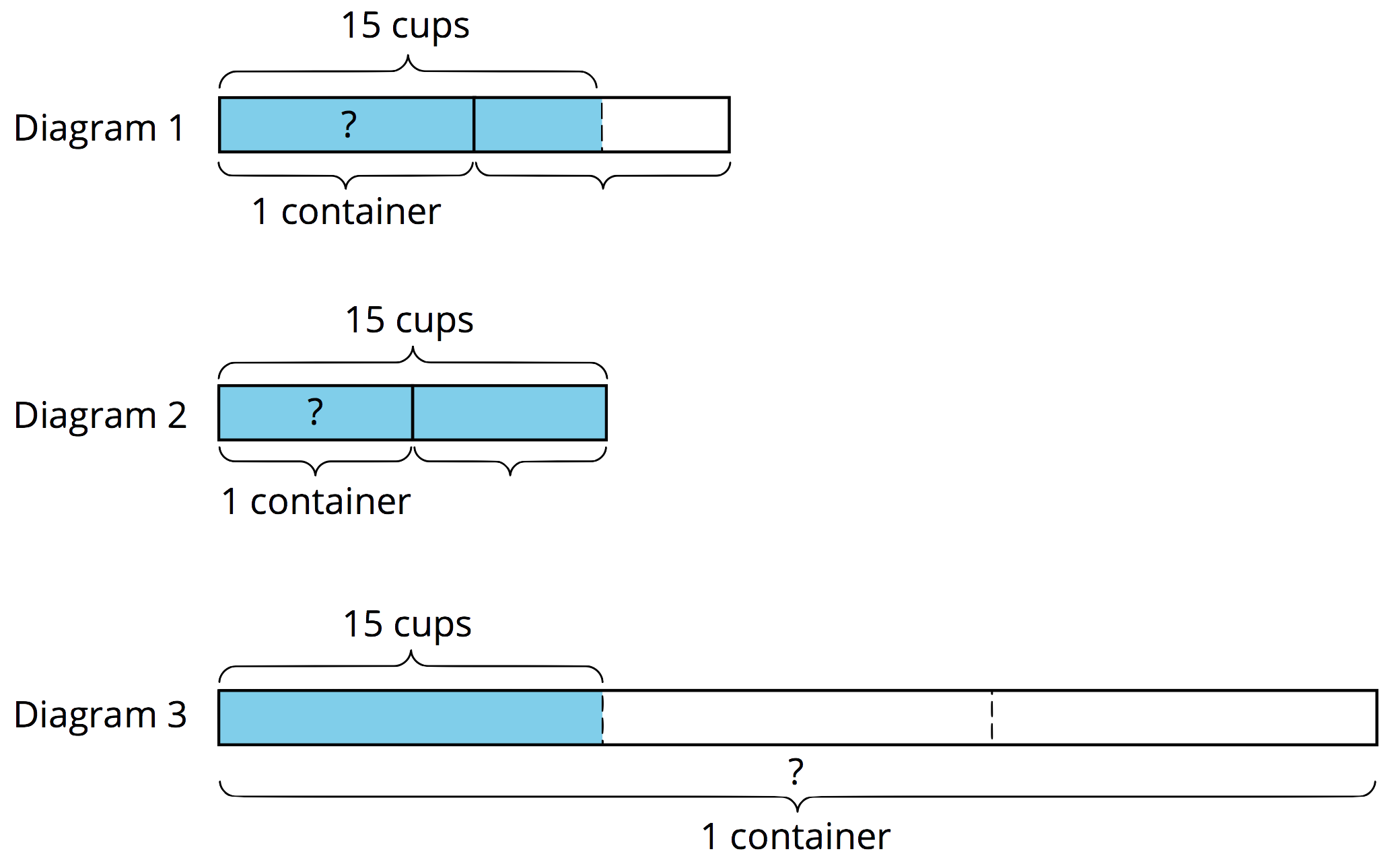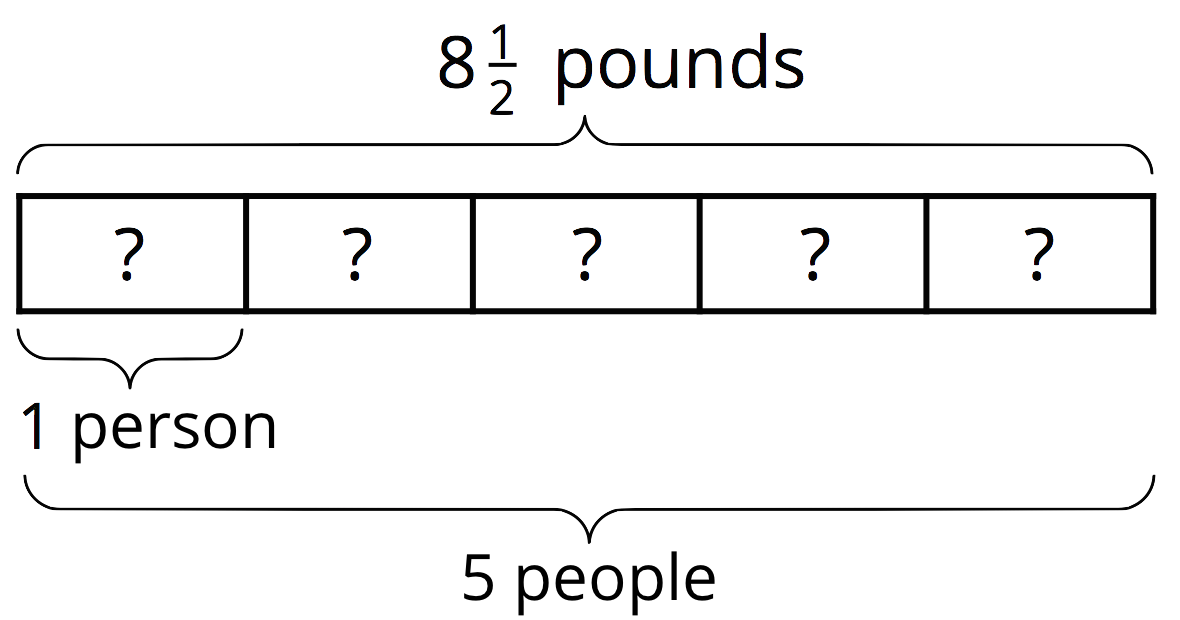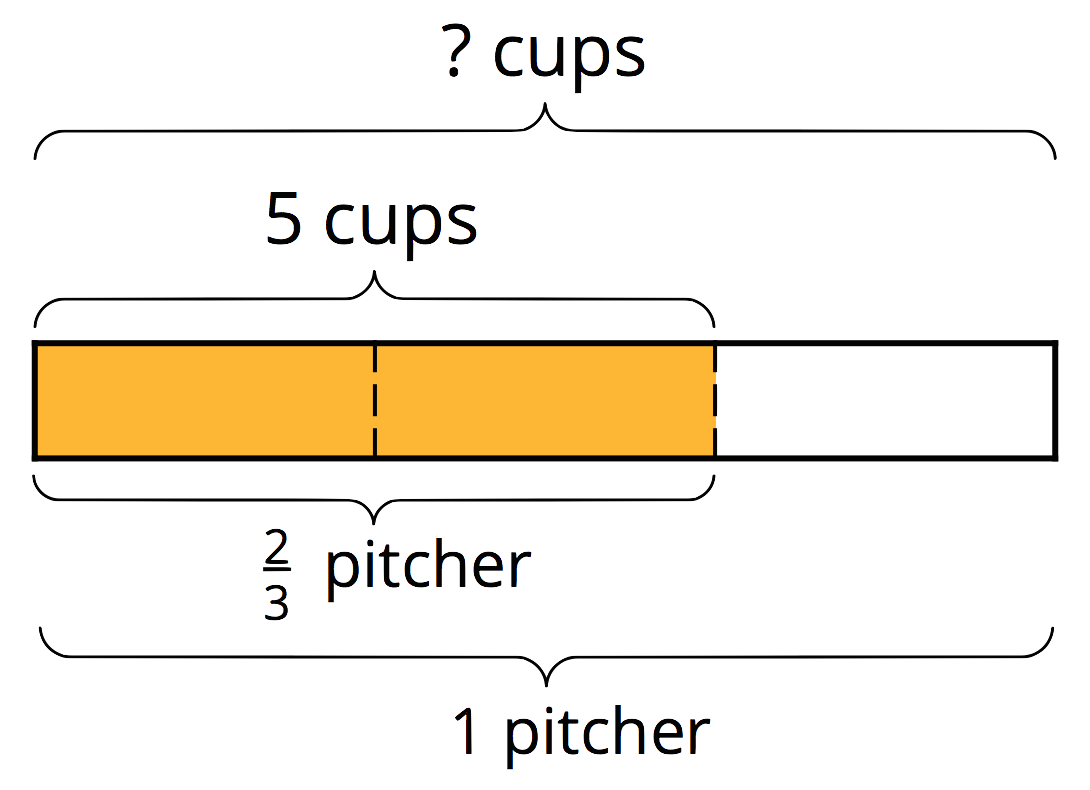Lesson 5
How Much in Each Group? (Part 1)
Let’s look at division problems that help us find the size of one group.
5.1: Inventing a Situation
- Think of a situation with a question that can be represented by the equation \(12 \div \frac23 = \,?\) Describe the situation and the question.
-
Trade descriptions with your partner, and answer your partner’s question.
5.2: How Much in One Batch?
To make 5 batches of cookies, 10 cups of flour are required. Consider the question: How many cups of flour does each batch require?
We can write equations and draw a diagram to represent this situation.
\(\displaystyle 5\, \boldcdot {?} = 10\) \(\displaystyle 10 \div 5 = {?}\)

This helps us see that each batch requires 2 cups of flour.
For each question, write a multiplication equation and a division equation, draw a diagram, and find the answer.
- To make 4 batches of cupcakes, it takes 6 cups of flour. How many cups of flour are needed for 1 batch?
- To make \(\frac12\) batch of rolls, it takes \(\frac54\) cups of flour. How many cups of flour are needed for 1 batch?
- Two cups of flour make \(\frac23\) batch of bread. How many cups of flour make 1 batch?
5.3: One Container and One Section of Highway
Here are three tape diagrams that represent situations about filling containers of water.

Match each situation to a diagram and use the diagram to help you answer the question. Then, write a multiplication equation and a division equation to represent the situation.
-
Tyler poured a total of 15 cups of water into 2 equal-sized bottles and filled each bottle. How much water was in each bottle?
-
Kiran poured a total of 15 cups of water into equal-sized pitchers and filled \(1\frac12\) pitchers. How much water was in the full pitcher?
-
It takes 15 cups of water to fill \(\frac13\) pail. How much water is needed to fill 1 pail?
Here are tape diagrams that represent situations about cleaning sections of highway.

Match each situation to a diagram and use the diagram to help you answer the question. Then, write a multiplication equation and a division equation to represent the situation.
-
Priya’s class has adopted two equal sections of a highway to keep clean. The combined length is \(\frac34\) of a mile. How long is each section?
-
Lin’s class has also adopted some sections of highway to keep clean. If \(1\frac12\) sections are \(\frac34\) mile long, how long is each section?
-
A school has adopted a section of highway to keep clean. If \(\frac13\) of the section is \(\frac34\) mile long, how long is the section?
To make a Cantor ternary set:
- Start with a tape diagram of length 1 unit. This is step 1.
- Color in the middle third of the tape diagram. This is step 2.
- Do the same to each remaining segment that is not colored in. This is step 3.
- Keep repeating this process.

- How much of the diagram is colored in after step 2? Step 3? Step 10?
- If you continue this process, how much of the tape diagram will you color?
-
Can you think of a different process that will give you a similar result? For example, color the first fifth instead of the middle third of each strip.
Summary
Sometimes we know the amount for multiple groups, but we don’t know how much is in one group. We can use division to find out.
For example, if 5 people share \( 8 \frac12\) pounds of cherries equally, how many pounds of cherries does each person get?

We can represent this situation with a multiplication equation and a division equation: \(\displaystyle 5\, \boldcdot {?} = 8\frac12\) \(\displaystyle 8 \frac12 \div 5 = {?}\)
\(8\frac12 \div 5\) can be written as \(\frac{17}{2} \div 5\). Dividing by 5 is equivalent to multiplying by \(\frac 15\), and \(\frac{17}{2} \boldcdot \frac {1}{5} =\frac {17}{10}\). This means each person gets \(1\frac {7}{10}\) pounds.
Other times, we know the amount for a fraction of a group, but we don’t know the size of one whole group. We can also use division to find out.
For example, Jada poured 5 cups of iced tea in a pitcher and filled \(\frac 23\) of the pitcher. How many cups of iced tea fill the entire pitcher?

We can represent this situation with a multiplication equation and a division equation: \(\displaystyle \frac 23 \boldcdot {?} = 5\) \(\displaystyle 5 \div \frac23 = {?}\)
The diagram can help us reason about the answer. If \(\frac23\) of a pitcher is 5 cups, then \(\frac 13\) of a pitcher is half of 5, which is \(\frac52\). Because there are 3 thirds in 1 whole, there would be \((3 \boldcdot \frac52)\) or \(\frac{15}{2}\) cups in one whole pitcher. We can check our answer by multiplying: \(\frac23 \boldcdot \frac {15}{2} = \frac {30}{6}\), and \(\frac {30}{6} = 5\).
Notice that in the first example, the number of groups is greater than 1 (5 people) and in the second, the number of groups is less than 1 (\(\frac 23\) of a pitcher), but the division and multiplication equations for both situations have the same structures.